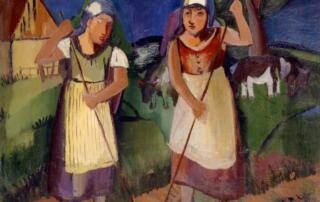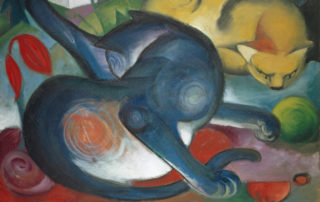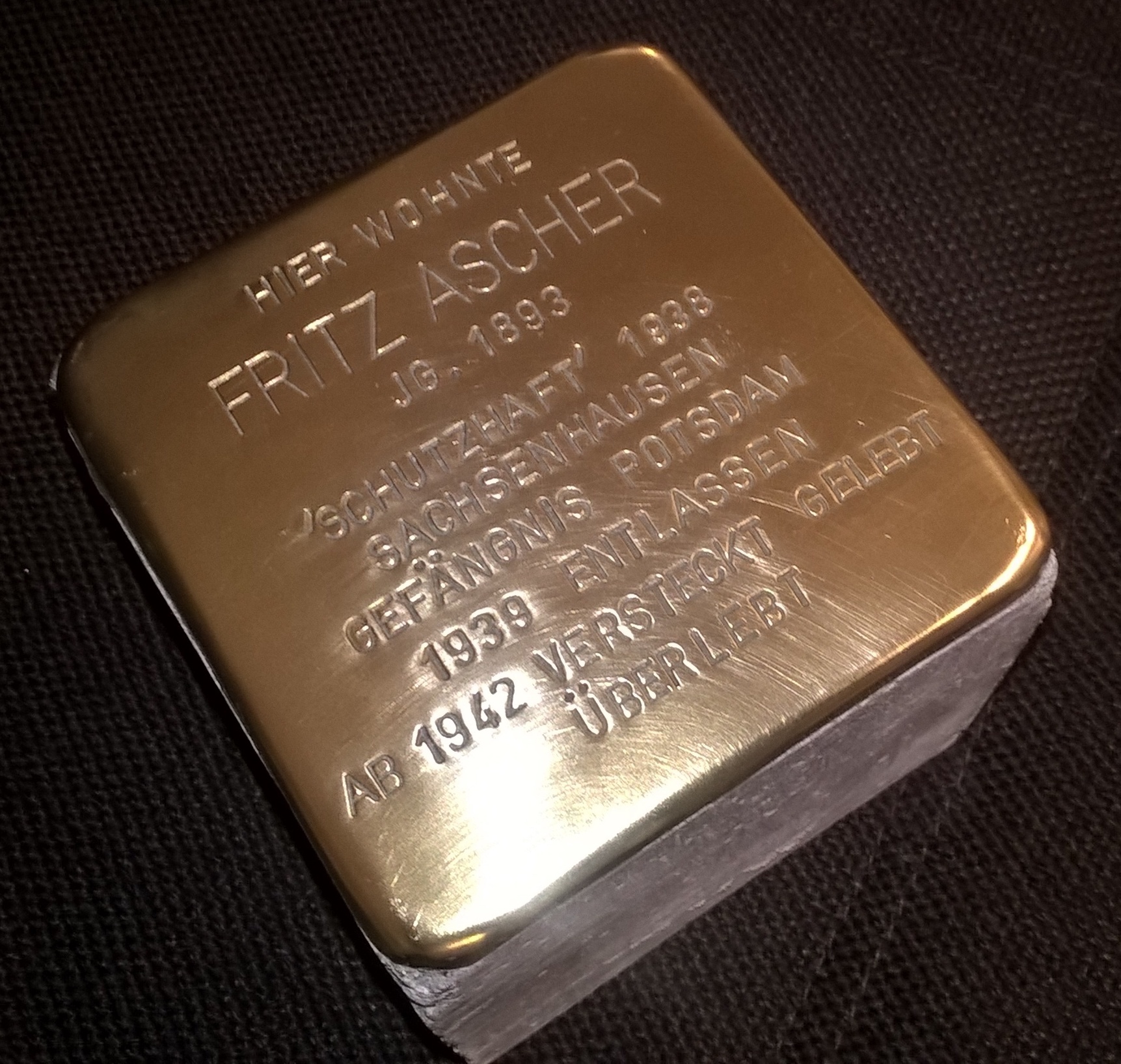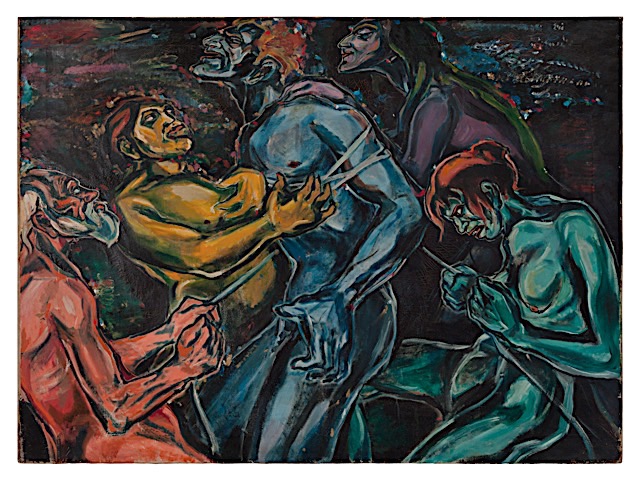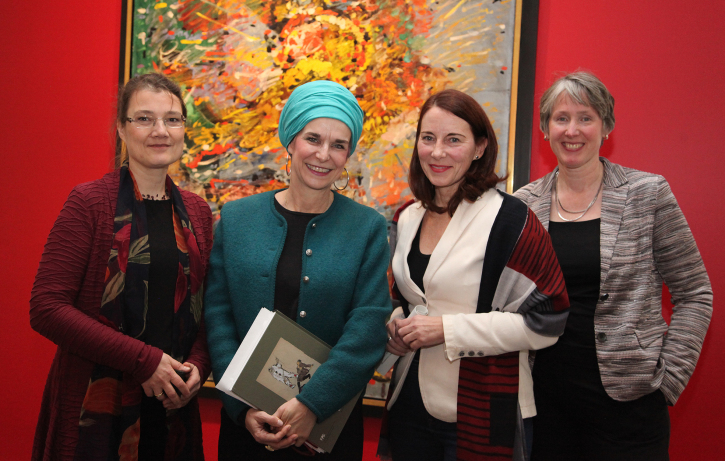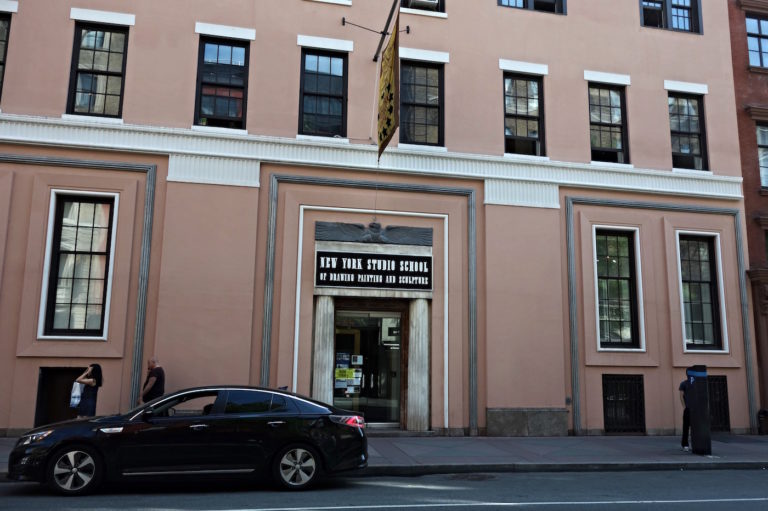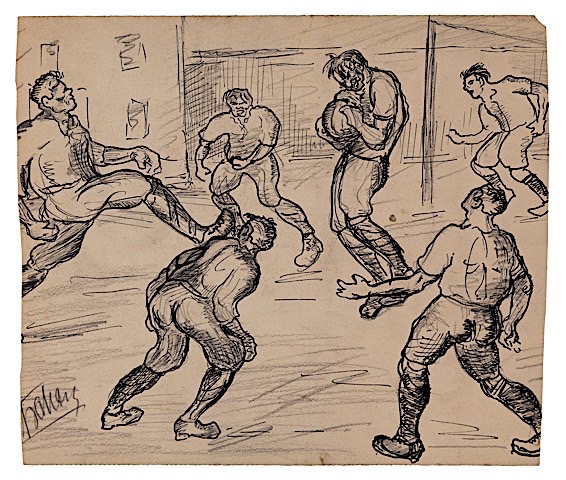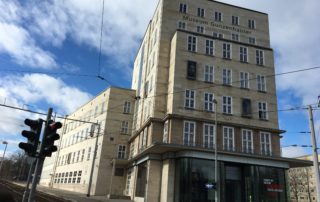Rachel Stern2024-02-28T14:34:35-05:00February 2nd, 2024|Events, Lectures, Past Events|
Searching, wandering, not arriving - this is how the person and art of Franz Domscheit/Pranas Domšaitis can be characterized. Born into a German-Lithuanian family as the son of a farmer and innkeeper, it was primarily his Lithuanian origins that interested him. The early landscape and cultural impressions of his homeland, Prussian-Lithuania, at the interface of German and Lithuanian culture, shaped his work throughout his life. Landscape is one of the painter's main themes, who is primarily perceived as an expressionist. Image above: Franz Domscheit, Two Peasant Women, 1930s. Oil on canvas. Copyright National Lithuanian Art Museum. Trained at the Königsberg Art Academy by Ludwig Dettmann, among others, Domscheit then moved out into the world. Berlin, [...]
Rachel Stern2023-02-06T07:18:23-05:00January 8th, 2023|Events, Lectures, Past Events|
The Kunstmuseum Basel’s department of classic modernism houses one of the most prestigious collections of its kind. It was in fact assembled at a comparatively late date. In the summer of 1939 — shortly before the outbreak of World War II — Georg Schmidt (1896–1966), the museum’s director at the time, managed to acquire twenty-one avant-garde masterpieces all at once. The works were among those denounced in 1937 by Nazi cultural policy as “degenerate” and forcibly removed from German museums. The Third Reich’s Ministry of Propaganda correctly assumed that a portion of such works would find buyers abroad and bring in foreign currency. In this way certain artworks deemed “internationally exploitable” reached the art market via various channels. [...]
Rachel Stern2018-12-04T11:50:09-05:00February 8th, 2018|Newsletter|
Dear Friends, Fritz Ascher is getting a “Stolperstein” (stumbling stone)! Please join us for the ceremony on Wednesday, February 21 at 11:00am at Niklasstr. 21/23 in Berlin-Zehlendorf Stolpersteine (stumbling stones) is a project of the artist Gunter Demnig. The project commemorates people who were persecuted by the Nazis between 1933 and 1945. Stolpersteine are concrete blocks measuring 10x10cm which are laid into the pavement in front of the last voluntarily chosen places of residence of the victims of the Nazis. Their names and fate are engraved into a brass plate on the top of each Stolperstein. In Berlin, thousands Stolpersteine were installed since 1996. Today, Stolpersteine can be found in 1099 German cities and in 20 European countries. (link) We [...]
Rachel Stern2018-12-04T11:57:56-05:00December 27th, 2017|Select Press Coverage|
Fritz-Ascher-Retrospektive „Leben ist Glühn“ Die Wiederentdeckung des Expressionisten Fritz Ascher: eine Doppelausstellung in der Villa Oppenheim und im Potsdam Museum. by Elke Linda Buchholz Einen so vollständig vergessenen Künstler zurückzuholen in die Aufmerksamkeit, braucht Kraft, Geduld und kreative Energie. Vor 30 Jahren stieß die deutsch-amerikanische Kuratorin Rachel Stern bei einem Sammler auf Arbeiten von Fritz Ascher. Sie hatte noch nie von ihm gehört. Jetzt ist sie als quasi weltweit einzige Expertin für den 1893 geborenen Maler wieder zurück in der Stadt, wo auch er einst gelebt und gearbeitet hat. Hier bei Max Liebermann holte der junge Wilde sich als 16-Jähriger nach abgebrochener Schule die höheren Weihen einer Empfehlung an die Königsberger Kunstakademie und startete zwischen Secessionisten und Expressionisten seine Karriere. [...]
Rachel Stern2018-12-04T12:05:52-05:00December 26th, 2017|Select Press Coverage|
Der vergessene Expressionist Das Potsdam-Museum zeigt Werke des von den Nazis verfolgten Malers Fritz Ascher by Mathias Richter Sie gehören zur sogenannten verlorenen Generation. Künstler wie Gertrude Sandmann, Magda Langenstrass-Uhlig oder Eric Isenburger. Sie hatten Anfang der 30er Jahre grosse Ambitionen und wahrscheinlich eine grosse Karriere vor sich. Doch mit dem Machtantritt von Adolf Hitler erhielten sie Berufsverbot, wurden verfolgt, ihre Werke als "entartete Kunst" verfemt. Wer die Nazi-Zeit überlebte war vergessen und stand vor dem Nichts. Einer der Angehörigen dieser verlorenen Generation ist Fritz Ascher. Das Potsdam-Museum widmet dem radikalen Berliner Expressionisten in Kooperation mit der Villa Oppenheim in Berlin-Charlottenburg von Sonntag an eine Sonderausstellung. 80 Gemälde und Grafiken sind in den beiden Museen zu sehen, davon etwa 50 [...]
Rachel Stern2018-12-04T12:07:01-05:00December 25th, 2017|Select Press Coverage|
Ein Zerrissener Das Potsdam Museum entdeckt Fritz Ascher, der sich in Potsdam vor den Nazis versteckte by Lena Schneider Wer war Fritz Ascher? Das Potsdam Museum hat diesem Unbekannten eine Sonderausstellung gewidmet. „Leben ist glühn“ heißt sie. Ein Bild, das hier hängt, kann man als bestürzende Antwort auf die Frage lesen. „Bajazzo“ heißt es, nach dem italienischen Bruder des Harlekin. Zu sehen ist eine schemenhafte Gestalt, in gelbem Kostüm. Im weiß geschminkten Gesicht ist so etwas wie ein trostloser Schatten des Clownsgenres auszumachen: schwarze Augen, die rot überzogen Mundwinkel krümmen sich nach unten. Das ganze Bild ist wie zerschossen von Farbpunkten. Die Antwort darauf, wer Fritz Ascher, geboren 1893 als Kind jüdischer Eltern, war, findet sich im Entstehungsdatum des Bildes: [...]
Rachel Stern2018-12-04T12:14:23-05:00December 22nd, 2017|Newsletter|
Dear Friends, I am humbled and honored to have received the Lea and Hans Grundig Prize for my work about Fritz Ascher. Right on time for his 125th birthday, the Fritz Ascher retrospective is now open in Berlin and Potsdam, the two places where the artist lived and worked. Museum Charlottenburg-Wilmersdorf in der Villa Oppenheim in Berlin exhibits an overview of the artist’s creative development, with a focus on works that relate to Berlin. We see his sketch of the artist Max Liebermann as well as his love for music and performance in Weimar Republic paintings like “Beethoven” and “Bajazzo and Artists”. After surviving the Nazi terror regime in hiding in the Berlin Grunewald neighborhood, he painted these works over [...]
Rachel Stern2018-12-04T12:15:18-05:00December 21st, 2017|Newsletter|
Dear Friends, Today I am excited to share with you some photos of last week’s opening of “Beauteous Strivings: Fritz Ascher, Works on Paper”, which is on view at the New York Studio School daily 10:00am-6:00pm until December 3 (website link). In this exhibition, “powerful emotions seem to lurk just beneath the apparent directness and economy of the tree and flower paintings” of the 1950s and 1960s, observes curator Karen Wilkin in the catalogue that accompanies the exhibition. She continues: “A sense of near-obsession, of ferocious concentration, of focus that excluded everything else, was palpable, made visible in the traces of his rapidly moving hand, driving across the paper, making loops and whorls, and then abruptly changing direction. At the [...]
Rachel Stern2018-12-04T12:33:00-05:00September 1st, 2017|Newsletter|
Dear Friends, It was fun to attend the opening of “Hauptstadtfussball” at the Ephraim Palais in Berlin, celebrating the 125th anniversary of the Berlin soccer club Herta BSC and its local rivals. I learned so many things about soccer in Berlin, and about Herta BSC in this creative, well researched exhibition. And you can see Fritz Ascher’s “Soccer Players” from c. 1916! It will be on view until January 8, 2018. link Thank you to Sven Goldmann for bringing Fritz Ascher alive in his full page piece in the German newspaper Der Tagesspiegel! link Here in New York, the preparations for “‘Beauteous Strivings.’ Fritz Ascher - Works on Paper” at the New York Studio School are in full swing. The New [...]
Rachel Stern2018-12-04T12:33:53-05:00July 10th, 2017|Newsletter|
Dear Friends, Time for the outdoors! What could be timelier than an exhibition about soccer. On July 26th, the Ephraim Palais in Berlin is opening “Hauptstadtfussball,” celebrating the 125th anniversary of the Berlin soccer club Herta BSC and its local rivals. In this exhibition, you can find Fritz Ascher’s “Soccer Players” from c. 1916! It will be on view until January 8, 2018: link Since the last newsletter, Wiebke Hölzer published two essays about Fritz Ascher, one in the Biographisch-Bibliografisches Kirchenlexikon (BBKL, vol. 38, Nordhausen 2017), and one called "Kunststück" examining his “Bajazzo” from 1924 in Weltkunst No. 129 from May 2017 (pp. 120-121). And our most accomplished lawyer, the author Nicholas O'Donnell, a veteran attorney and litigation partner at the [...]
Rachel Stern2018-12-04T12:36:20-05:00February 28th, 2017|Newsletter|
Dear Friends, Thank you for supporting us with your interest in our work, reading our newsletters and publications and/or visiting our exhibitions, and - last not least - supporting our work financially. 2016 was the first year that our work started showing, with the participation in the exhibition Verfahren. "Wiedergutmachung" im geteilten Berlin / »Making Amends« Compensation and Restitution Cases in Divided Berlin at Aktives Museum Berlin (October 9, 2015 - January 14, 2016) and Landgericht Berlin/Amtsgericht Mitte, Berlin (September 29 - November 18, 2016) and the long anticipated first ever retrospective with its comprehensive catalogue (link) "Leben ist Glühn" Der Expressionist Fritz Ascher / “To Live is to Blaze with Passion" The Expressionist Fritz Ascher at the Felix-Nussbaum-Haus Osnabrück [...]
Rachel Stern2018-12-03T16:21:23-05:00January 12th, 2017|Exhibitions, Past Exhibitions|
The worldwide first Fritz Ascher Retrospective is on view at the Kunstsammlungen Chemnitz - MUSEUM GUNZENHAUSER from March 5 to June 18, 2017. (website link) The main focus of the presentation at the Kunstsammlungen Chemnitz - MUSEUM GUNZENHAUSER is on the artist's important early masterworks like "Golgatha" (1915), "Bajazzo and Artists" (ca. 1916) and "The Tortured" (ca. 1916). For the first time ever, Fritz Ascher’s “Golem” from the collection of the Jewish Museum Berlin will here be reunited with other works the artist created between 1913 and 1933. The Kunstsammlungen Chemnitz is home to an important collection of German Expressionism, dominated by artwork of the locally founded Expressionist group Brücke and especially Karl Schmidt-Rottluff, who grew up in Chemnitz, along [...]


